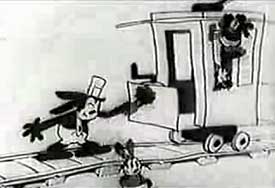 0swald the Lucky Rabbit was extremely famous in the late 1920s & '30s. Walt Disney & Ub Iwerks designed the character but as they were contracted to Universal they retained no rights, & their boss Charles Mintz was never really on their side when it came to assuring quality cartoons.
0swald the Lucky Rabbit was extremely famous in the late 1920s & '30s. Walt Disney & Ub Iwerks designed the character but as they were contracted to Universal they retained no rights, & their boss Charles Mintz was never really on their side when it came to assuring quality cartoons.
Trolley Troubles (1927) was the very first Oswald theatrical release. It is very primitive for drawing & for incident. Oswald would only slowly become more sophisticated.
In terms of story sophistication & smoothness of animation, the best episodes would be those overseen by Walter Lantz in later years. But given the ridiculously low budgets Walt Disney had for the character, he managed to invest each episode with a primitive charm.
Walt & Ub had made an Oswald cartoon earlier in 1927 called Poor Papa but Universal would not release it due to its all round inferiority.
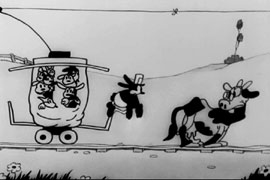 Walt assisted by Ub tried harder for Trolley Troubles but for the two years Walt was at Universal, he was hamstrung by minimum budgets & extreme time restraint. Walt assisted by Ub tried harder for Trolley Troubles but for the two years Walt was at Universal, he was hamstrung by minimum budgets & extreme time restraint.
Walt knew the cartoons weren't great. When for the second year he asked Mintz to go to bat for him at Universal for more realistic budgets, Mintz instead demanded he take a budgetary cut of twenty percent.
So Walt quit & set out on his own, bringing Ub Iwerks & Les Clark with him, though most of Walt's animation team had already be reasigned to Universal.
But before Walt was through with his contract at Universal he would have overseen 23 Oswald cartoons, nine in 1927, 14 in 1928, not counting "Poor Papa."
Mintz would take over for the rest of '28 & part of '29, with his brother-in-law, George Winkler helming the Oswald films. Universal was decreasingly pleased with this worsening work, & in 1929 Walter Lantz took over.
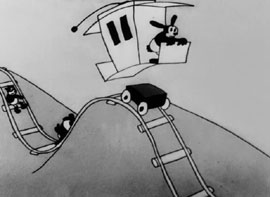 Lantz stayed with Oswald until the series ended in 1938. Ironically in 2006 the Disney company purchased the rights to all these cartoons, so Oswald ended up with his creator's company after all. Lantz stayed with Oswald until the series ended in 1938. Ironically in 2006 the Disney company purchased the rights to all these cartoons, so Oswald ended up with his creator's company after all.
Initially a silent film, Oswald's first sound film would be in 1929, & Mickey Rooney was Oswald's first voice. The earlier cartoons in re-release, including Trolley Trouble in 1931, & Oh, Teacher in 1932, etc., had a few sound effects added along with music, & Oswald would make wordless sounds here & there.
Simple line drawings show Oswald & his troop of bunnies playing around a trolley car. Oswald is distinguished from the other bunnies only be being drawn a bit bigger & wearing a trolley conductor's hat.
He dusts the trolley (with his bunny tail), oils the wheels, adjusts the workings, & takes off down the track. A number of simple gags follow, nothing at all remarkable. Perhaps the cleverest gag is how Oswald tricks an angry billygoat into powering the trolley up a steep hill.
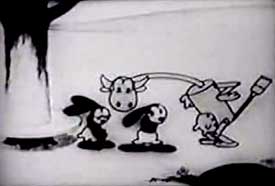 In The Mechanical Cow (1927), Oswald the Lucky Rabbit tries to get his roommate the robot cow out of bed for the morning milking, but she wants to sleep in.
In The Mechanical Cow (1927), Oswald the Lucky Rabbit tries to get his roommate the robot cow out of bed for the morning milking, but she wants to sleep in.
Forcing the cow to get up, we see that she has a whiskbroom for a tail, a large round can for the main part of her body, but her head looks like it might've come from a real cow.
Oswald wants to exercise his mechanical cow by forcing her to climb atop a sliding board & slide down. She's got roller skate feet & with Oswald riding on her back, the mechanical cow sets off down the road, stopping along the way to provide fresh milk to customers.
Oswald meets a gal rabbit & sends the mechanical cow away dejected in order to court the girl. While he's making time with her, a weary car comes to a halt nearby, & a weird monstrous fellow materializes, kidnaps the girl, & dashes away with her in his auto.
Our not-so-lucky rabbit runs after the car but can't go that fast until the cow races to the rescue as his fearless steed. Gangsters shoot out the back of the car & eventually everyone goes over a cliff except the mechanical cow.
The gangsters meet their doom, but the boy & girl rabbit catch themselves on a limb, climb back up, & ride away together on the robot cow.
More imaginative than most of the early Oswalds, the style is yet extremely primitive.
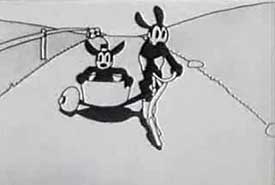 Oh, Teacher (1927) provides such a momentary glimpse of a school teacher that the title has nothing to do with anything. The cartoon itself ain't much, as Universal didn't give its animators great leeway to be creative at this time.
Oh, Teacher (1927) provides such a momentary glimpse of a school teacher that the title has nothing to do with anything. The cartoon itself ain't much, as Universal didn't give its animators great leeway to be creative at this time.
Oswald the rabbit rides along in his bicycle with sidecar & picks up his girlfriend for the sidecar.
A bully of a cat knocks Oswald off his bike & takes off, crashing the bike & sending the sidecar flying into a pond. Oswald rides the word HELP! to the rescue, but the bully cat manages to take credit for saving her.
Denied credit for his heroics, Oswald boxes with the cat, getting the worst of it. A mouse rings the schoolbell & all the young animals rush into class. At recess, Oswald lies in wait with a brick to attack the cat, but the cat sneaks up behind & wacks Oswald.
A recurring gag for the lucky rabbit is to remove his foot, kiss it, rub it on his ear, then reattach it. This time he rubbed his foot on the brick. So when the bully takes it away from him & tosses it on the roof of the school house, the brick comes down through the drainspot & knocks the bully unconscious.
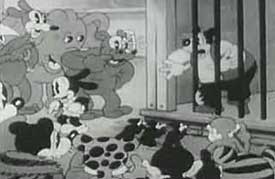 "Oswald Rabbit presents" In the Zoo (1933), & plays his concertina for the caged animals. "Oswald Rabbit presents" In the Zoo (1933), & plays his concertina for the caged animals.
Starting a cartoon with an accordion or concertina is a hold-over from themes of the silent era, as in Oh, What a Knight, when theater organs with pull-stops could imitate such instruments.
When cartoons became talkies, getting words to match up with mouth movements was still technically time consuming, & music was preferred.
The main tune here is "Little Brown Jug." Even a sung lyric, by right of its beat, was easier to match to movement than was mere speaking, as when a kangaroo sings "Ha! Ha! Ha!"
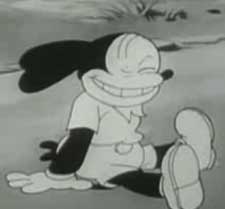 Several dancing & performing animal gags procede, including a lyre-bird playing its tail like a harp, a maned lion pulling his mane down around his waist to dance a hula, & so on. Several dancing & performing animal gags procede, including a lyre-bird playing its tail like a harp, a maned lion pulling his mane down around his waist to dance a hula, & so on.
Enter the villain, a peg-leg dog of a zookeeper who dislikes concertina music & gives Oswald a hard toss into a shed.
Further cruelty gags are shown as the zookeeper locks up Oswald inside the shed & sets out to abuse various animals in their cages. So much animal abuse really isn't that funny.
It's up to Oswald to escape & repair most of the damage done by the zookeeper, with gags that aren't too bad. This induces a severe thrashing from the zookeeper while the animals chant "We Want Oz Wald! We Want Oz Wald!"
At last the animals unite against the zookeeper in this non-stop gag-fest, making him the caged beast in the end.
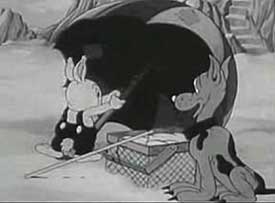 Oswald's design changed from time to time. In early Disney Oswalds, he has longer & much more animate ears, & he's predominantly a black bunny. For In the Zoo Walter Lantz shortened the ears but he's otherwise a black bunny as Ub & Walt colored him.
Oswald's design changed from time to time. In early Disney Oswalds, he has longer & much more animate ears, & he's predominantly a black bunny. For In the Zoo Walter Lantz shortened the ears but he's otherwise a black bunny as Ub & Walt colored him.
Yet in Beach Combers (1936) he has white ears & body, becoming a white bunny in black bib overalls instead of a black bunny in white shirt & shorts, & his ears are by now downright stubby.
A family of ducks heads off to the beach with their relaxation gear. The baby ducklings with sand-buckets & little shovels have their names on the buckets. The white ducklings are named Fee, Fi, Fo & Fum. The fifth duckling is black & his name is Fooey.
Oswald & his doggy Elmer come to the beach with a big shade-umbrella, fishing pole, & picnic basket. Oswald sets up the umbrella & tells Elmer to guard their lunch while Oswald goes to do a little fishing in a dingy. The baby ducklings set out to trick Elmer out of the food.
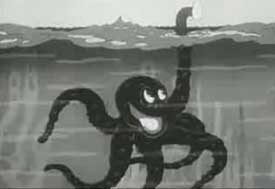 For such cute ducklings they're much too cruel to the good dog to be particularly sympathetic. For such cute ducklings they're much too cruel to the good dog to be particularly sympathetic.
As for Oswald, he's not much to be seen until near the end, having been used at the beginning of the tail as a figure of fear, since Elmer believes he'll be punished if he fails to protect the picnic basket.
When the ducklings are nearly killed by a mean old octopus, the duck father is too inept to help, & even Oswald screws up his attempt.
So it's up to the badly treated Elmer to save his enemies. Through it all, the octopus is much the best character in the film.
Oswald cartoons under Walter Lance were very well drawn, but one actually laments the primitive Oswald whom Walt Disney & Ub Iwerks created.
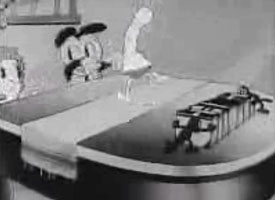 Oswald the Lucky Rabbit is seated alongside a cupie doll sort of gal, mutually playing jazz on a piano in Oswald's home. Puppies play a concertina, one on each side of the squeeze box.
Oswald the Lucky Rabbit is seated alongside a cupie doll sort of gal, mutually playing jazz on a piano in Oswald's home. Puppies play a concertina, one on each side of the squeeze box.
A dildo-like object is dancing on the lid of the piano. It's really an electric battery-operated "candle" which would've been instantly recognizable in the 1930s.
Before it starts dancing its got a tiny lampshade on top, but the shade slips down to around its waist like a mini-skirt as it begins to shimmy. It looks so much like a dancing olisbos one has to wonder if it wasn't one of the animator's pre-code subversive jests.
Though Oswald can afford a piano, you can tell by the worn out shade on the floorlamp that he's not a wealthy rabbit, & by the crooked picture hanging on the wall that he's not entirely tidy. But it's a homey place.
Somewhere down the block at another residence, Pegleg Pete the evil scientist is winding up his recently completed robot. Pete is a peglegged bear, but his ears are rather longish this time, he looks like a giant rabbit.
When the robot's fully wound, it immediately tries to beat the crap out of its own inventor. Pete locks him out of the house, & says to himself, "It needs a human heart. I'll get one!"
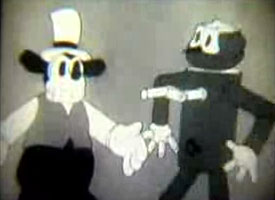 Oswald is juggling & doing magic tricks to entertain his girlfriend. Suddenly she is kidnapped by the evil inventor, & Oswald sets out to save the damsel in distress. Oswald is juggling & doing magic tricks to entertain his girlfriend. Suddenly she is kidnapped by the evil inventor, & Oswald sets out to save the damsel in distress.
Most sight gags in early cartoons are pretty much drawn from a finite set of gags used over & over, but for The Mechanical Man there are a couple suprisingly original ingredients.
For instance, when the inventor first tries to take the girl's heart, it jumps out of her mouth & runs about very boldly outwitting attempts to be captured. The heart then leaps back into the girl's mouth, as she lies helplessly in the grip of a workbench vice.
Oswald has arrived at the door by a clever means, & the inventor turns on his television monitor to see who is trying to get in. The monitor would've been very futuristic in 1932.
Oswald falls through a trapdoor in the welcome mat & ends up in the dungeon-like basement experiencing a series of Halloween-type gags while the villain chases him from room to room with an axe.
A live skeleton crawls out of beheaded suit of armor, & reclaims its skull from the inside of the helmet. A "ghost" turns out to be a sheet animated by a nutty looking parrot. A tiny mouse hole turns out to be the entry to a lion's rather than a mouse's residence.
The mice dial the cops, who are keystone goofballs & not much help. Throughout we've not seen the mechanical man, but he shows up at the last minute to attempt an evil deed, only to be broken to bits by a head-butting goat, while Oswald frees his girlfriend from the vice.
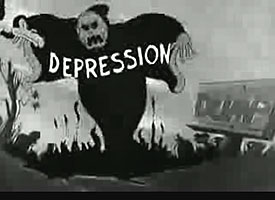 Confidence (1933) opens with a rooster at dawn singing revele on a fencepost: "Cocka-doodle-doodle-do, Cocka-doodle-doodle-do, Cocka-do, Cocka-do, Cocka-do!" He's so manly & expressive in his duty. Confidence (1933) opens with a rooster at dawn singing revele on a fencepost: "Cocka-doodle-doodle-do, Cocka-doodle-doodle-do, Cocka-do, Cocka-do, Cocka-do!" He's so manly & expressive in his duty.
The barnyard animals are already up & active, however. A cat is practicing boxing with a hog sparring partner, a figure who'd recur in later episodes as Punchy Pig. A billy goat is playing something like a washtub bass made from a milk bucket & his beard.
An unlikely barnyard animal, the champanzee, dances & grins. Mice play drums by leaping from snare to bass. Dogs play banjo & a toy piano. Chickens line-dance.
The rooster tells the hens to get to work & they begin laying. Oswald shows up to gather eggs. One tiny hen, Mildred, brings him an egg she laid that's bigger than she is. A huge hen, Janice, brings him a teeny tiny egg. An ashamed & weeping hen admits she couldn't lay a thing.
That night Oswald says good night to the "girls." Outside in the dark of night, a vulture circles, & a ghostly figure with the word "Depression" emblazoned across his chest rises from flaming garbage dump.
The frightful figure flies through the night cursing houses as he goes, then enters Oswald's henhouse. Next morning, a scrawny rooster can barely squeek out his faded revele. Hens stagger out of the chicken coop like drunkards ready to pass out. "Doctor Doctor!" cries Oswald, as we see scenes of the crashing stock exchange & general poverty in the world.
Oswald heads for Washington, D.C., to consult with President Roosevelt. A caricature of Roosevelt gives Oswald a singing lecture called "Confidence!" Oswald reaches into a cracker barrel of confidence with a bug-spray device & fills the sprayer. He heads back home to the on a propellor-powered statue's toupee.
In his village then on the farm he sprays everyone with confidence & soon everything is happy again, recycling some of the animation from the episode's beginning. Oswald sings an upbeat tune called "New Day Dawning." Great to see such practical advice for hard times!
copyright © by Paghat the Ratgirl
|
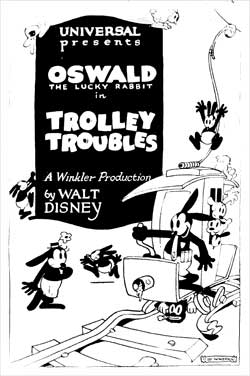

 Walt assisted by Ub tried harder for Trolley Troubles but for the two years Walt was at Universal, he was hamstrung by minimum budgets & extreme time restraint.
Walt assisted by Ub tried harder for Trolley Troubles but for the two years Walt was at Universal, he was hamstrung by minimum budgets & extreme time restraint. Lantz stayed with Oswald until the series ended in 1938. Ironically in 2006 the Disney company purchased the rights to all these cartoons, so Oswald ended up with his creator's company after all.
Lantz stayed with Oswald until the series ended in 1938. Ironically in 2006 the Disney company purchased the rights to all these cartoons, so Oswald ended up with his creator's company after all.


 Several dancing & performing animal gags procede, including a lyre-bird playing its tail like a harp, a maned lion pulling his mane down around his waist to dance a hula, & so on.
Several dancing & performing animal gags procede, including a lyre-bird playing its tail like a harp, a maned lion pulling his mane down around his waist to dance a hula, & so on.
 For such cute ducklings they're much too cruel to the good dog to be particularly sympathetic.
For such cute ducklings they're much too cruel to the good dog to be particularly sympathetic.
 Oswald is juggling & doing magic tricks to entertain his girlfriend. Suddenly she is kidnapped by the evil inventor, & Oswald sets out to save the damsel in distress.
Oswald is juggling & doing magic tricks to entertain his girlfriend. Suddenly she is kidnapped by the evil inventor, & Oswald sets out to save the damsel in distress.